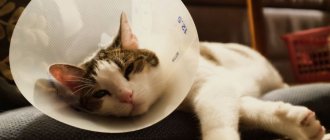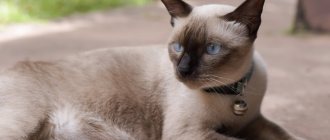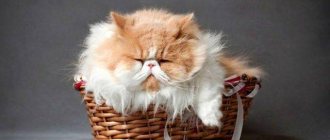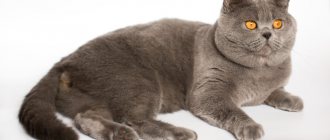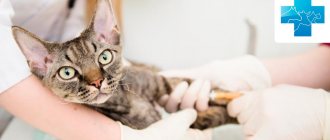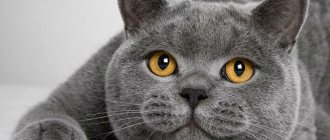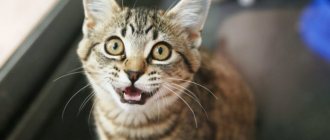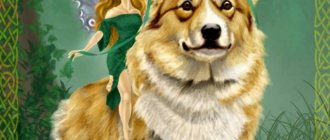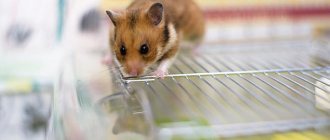History of the breed
The history of the discovery of the Scottish Fold breed is very interesting. In the early 1960s, a man named William Ross was walking in a place called Angus, in Scotland. There, on one of the farms, he met an unusual cat, whose ears were folded down, which gave the impression that the animal’s head had a regular round shape. The man persuaded the pet's owner to sell the animal, and Scottish Fold cats became known outside not only Scotland, but also the mainland.
Scottish fold cat
In 1978, the breed was presented at the World Pet Show in the USA. In 1993, the Scottish Fold was officially registered.
Description of the breed
The Scottish Fold is a very kind, calm and balanced breed. Such a cat will not run around the apartment all day long, jump out of the window while hunting birds, or damage furniture and other things in the house. He prefers a quiet lifestyle, but one must understand that there is also a share of activity. If an animal sits locked up all day and does not move, it will die.
Relationships with other animals and children
Scottish Folds are obedient, non-hyperactive animals. They treat children warmly, play and communicate with them without letting out their claws. They are indifferent to other people's children who come to visit, but they will humbly allow themselves to be touched and stroked.
Scottish Folds do not conflict with other animals, allowing them to dominate.
There are few conflicts with these pets, and they are rarely considered direct initiators of conflicts. Scottish Fold cats are tactful and forgiving, not subject to impulsive reactions. Behavior that goes beyond the boundaries is observed in them extremely rarely, much less often than in representatives of other breeds.
How long do Scottish Fold cats live?
One of the most fashionable breeds of domestic cats today is undoubtedly the Scottish Fold. These animals have short, silky to the touch, thick, beautiful fur, with very different colors. The eyes of this breed are unusually beautiful: large, expressive, and the color matches the cat’s coat color. The upper part of the ears covers the ear opening and hangs down, which is why the breed got its name.
Caring for a Scottish Fold
The Scottish Fold Shorthair is not very demanding in grooming, is not subject to heavy shedding, and sometimes needs to be brushed with a soft brush to remove loose hairs. More attention should be paid to caring for the cat’s eyes, teeth, cleaning the ears, and trimming the cat’s claws. These procedures should be carried out weekly.
Interesting information about the representatives of the breed
Highland fold (Scottish fold longhair cat)
Scottish cats have not only an unusual appearance, but also a special behavior. They can often stand on their hind legs for a long time, which they do not to attract attention to themselves, but to stretch their spine. Fold-eared pets are also afraid of heights, so they do not climb onto cabinets and curtains.
Some representatives of the breed sometimes have erect ears, so they are confused with another Scottish Straight breed. This can lead to unpleasant consequences, as inexperienced owners often mix straight-eared folds with straights, and sick mixed-breed kittens are born.
History of the Scottish Straight cat breed
Scottish straight cat
Scottish Straights are the same Scottish Folds, but with a modified position of the ear. Straight ears do not have a characteristic crease and are set straight, and this, in fact, is the only external sign that distinguishes them from their fold-eared counterparts. Scottish cats are considered one of the youngest cat breeds. The first cat with an unusual, flattened ear shape appeared on a Scottish farm in the early 60s. Surprisingly, the ancestor of modern folds and straights had no pedigree and simply chased mice through the barns of local peasants.
The first official Scottish breeder was an ordinary villager, William Ross, who adopted a kitten from the aforementioned Fold. A few years later, professional breeders also joined the process. At the same time, experts witnessed an interesting phenomenon: in the litters brought by even the most purebred Scottish dogs, babies with erect ears appeared. Of course, no one intended to separate such individuals into a separate breed. And kilometer-long queues did not line up for straight-eared kittens, because against the backdrop of touching folds, they were outright losing. But here nature itself intervened.
Very soon, Scottish breeders noticed that attempts to strengthen and strengthen the lop ears of animals had a negative impact on their health. The mutated gene responsible for the flatness of the ear folds began to inhibit the function of the skeletal apparatus of cats. As a result, the Scots began to suffer from thickening of the bones and osteochondrodysplasia. To keep the breed afloat, breeders rushed to look for “new blood” that would help the Scottish survive and reduce the number of their genetic defects. Through trial, error and outcrossing, it was discovered that the healthiest and most beautiful offspring can be obtained from crossing a Fold cat and a straight-eared male of the same breed. It was thanks to this discovery that breeders and felinological associations finally turned their attention to straight-eared Scots. Well, in 2004, the Scottish Straight subspecies received official recognition from the World Cat Federation and the status of an independent breed, which sharply increased the attractiveness of straight-eared cats in the eyes of potential buyers.
>Video: Scottish straight cat
What affects the duration
There are several factors that can significantly shorten the lifespan of a Scottish cat:
- Weak bones. This breed is prone to problems with bone and cartilage development. Such problems can appear in adulthood.
- Tendency to obesity. An unbalanced diet quickly leads to excess weight gain, and this, in turn, negatively affects the functioning of the heart and liver.
- In the long-haired variety (Highland Straight), without regular combing, the hair becomes so dense that it prevents the animal from moving. In advanced cases, this even leads to physical inactivity, that is, weakening of muscles due to lack of mobility. In addition, dense clumps of such wool are difficult to remove from the animal’s stomach and cause disturbances in the gastrointestinal tract.
- The lop-eared type is especially susceptible to problems with the ears - wax and dirt quickly accumulate in them. If they are not regularly examined, the onset of the inflammatory process or the appearance of mites may go unnoticed and lead to serious complications.
Appearance
British Fold is a Scottish breed of cat.
Scottish Folds have a fairly well-fed and powerful body. Cats come in different colors, the most popular being gray fur. The color of cats is divided into two groups: plain and patterned.
Patterned marbled color
Solid colors of fur are classified as monochromatic: white, black, gray, blue, red, chocolate, lilac.
The patterned colors include the following:
- spotted, round or oval-shaped spots on the back, sides and tail;
- marble, patterns in the form of a ring and a half ring;
- colorful, small spots and dots on the limbs and head, which are much darker and more contrasting against the background of the main color of the fur;
- chinchilla, a small part of the hairs is colored white or black, for example, completely blue cats may have white hairs on the abdomen or limbs.
Dimensions and weight of fold cats
Scottish cats are usually medium in size, but their bodies are stocky and muscular. The average weight of cats is about 4-7 kilograms, and cats are much heavier, ranging from 7 to 10 kg.
Ears
The ears are set wide on the head, “hanging” towards the bottom, but turned forward. They are small in size and rounded at the ends.
Eyes and nose
Large folded eyes with a perfect round shape. They are quite wide open, which gives the impression that the cat looks surprised.
The short nose is wide and straight. The animal has an excellent sense of smell, which makes British cats one of the best hunters among domestic cat breeds.
Torso and limbs
The chest, shoulders and back are wide compared to the rest of the body, the neck is short. The hind legs are short but muscular. The tail is also short and rounded at the tip.
Head
The cat's wide and massive head is shaped like a circle, and its chin is firm. The cheeks of a pet are wide and plump, in addition, the whisker pads are also round. The mustache is long and clearly defined.
British Folds love to stand on their hind legs.
Exterior Features
Those who want to know how long British cats live at home would do well to familiarize themselves with the breed standard. These are medium or large, broad-boned, squat animals with well-developed muscles. A distinctive feature of these individuals is their beautiful plush fur. On the large round head are widely set, slightly rounded ears. The color of the eyes depends on the shade of the fur.
The standard provides several possible coat tones. Representatives of this breed can have tortoiseshell, bright red, lilac, black, white, chocolate, cream and blue-gray fur. A characteristic feature of the British is considered to be a muscular body with a wide back, turning into a thick, tapering tail.
Those who want to understand how long a British cat lives will be interested in how these animals behave. Let us immediately note that the luxurious handsome men have a rather friendly disposition. But, despite their easy-going nature, they have their own opinions.
During the first meeting, this aristocrat can give the impression of an extremely unfriendly creature. But once she understands who she has to deal with, she will become more sociable. In addition, representatives of this breed are very freedom-loving and will not tolerate inconvenience. They will never lie next to their owner against their will. The British are very active and playful. Even at an advanced age, they will not refuse to run after the ball.
Caring for an adult pet
An animal with the following signs is taken from the nursery:
- healthy;
- well-mannered;
- grafted.
But this does not mean that the cat’s manners are not worth working on. As the child grows up, he develops his own habits and character traits.
As the Scot grows, you have to change the container for the toilet, purchasing a tray with deeper walls. An adult animal can show its condition by behavior: meowing or marking corners and furniture.
Breeding should be carried out by experienced breeders, or owners who have studied and tested in practice all the nuances of crossing representatives of the breed. The sale of kittens is planned: you need to prepare to select a partner, preferably from the same club.
How long do cats live (sterilized and unsterilized at home)
Neutered Scottish Fold cats at home live longer than usual by an average of 3 years. There is an opinion that you need to let the cat know the joys of motherhood. This is not true: carrying a baby will weaken the body of an adult animal. A Scottish cat that is brought into the house as a pet is advised to be sterilized.
How long do cats live (neutered and non-castrated at home)
If the cat does not participate in a breeding career, you need to think about castration. After the operation there is no need to search for a female. But this event does not affect life expectancy in any way. Neutered pets live as long as their non-neutered counterparts.
Character and behavioral characteristics
Along with the external description, the character of the fold-eared breed also differs from other representatives of the cat world. These are very well-mannered, proud and calm cats. Scottish cats are aristocrats in their origin and behavior. They immediately understand what people want from them and obey them. However, if they don’t like something, they can show their stubborn and unapproachable nature.
Golden chinchilla - a cat with a special character
Sometimes these cats stretch their legs forward and take a strange pose, as if they are meditating. They love to sleep on their backs rather than curled up in a ball. Scots love to have their fur brushed or massaged.
Representatives of the Scottish Fold breed meow very rarely and quietly. They speak only when absolutely necessary and are not used to disturbing others needlessly. Moreover, unlike other representatives of the cat family, fold-eared cats do not impose themselves on their owners asking them to caress and stroke them. They love to be close, but not constantly sit in a person's arms.
Interesting! While still kittens, Folds do not cause much trouble to their owners. However, Scottish kittens love to hide small objects from their owners in corners and secluded places.
Children and other animals
Fold cats are the most loyal and loving. They become very attached and most importantly respect their owners. The breed is famous for its ability to find a common language not only with all representatives and friends of the family in which they live, but also with other pets.
Representatives of this breed get along very well with children. They are attentive to the child and do not fight or scratch. Fold-eared Scots can become the most devoted and well-mannered friends for children for many years.
Scottish Folds are good with children
Find out how long Scottish Fold cats live?
Scottish cats are interesting animals with an unusual view of what is happening. These fold-eared cats talentedly combine caution, slowness and regularity - they received so many qualities in their homeland, in the British Kingdom, the only island in central Europe.
The owners affectionately call their pets of this breed “fluffy happiness” when they tell their friends about them. This is understandable: fold cats are incredibly charming and cute, and their calm disposition is perfect for the modern lifestyle.
The article will tell you how long cats of the Scottish breed live, tell you about hidden details of character, temperament, and estimate the average level of health.
Detrimental environmental factors
Scottish cats were bred as a decorative breed; they are not adapted to life on the street. Cats do not tolerate temperature changes well. The danger for them is drafts, which can cause colds.
Scottish Folds have a delicate nervous system. They do not tolerate stressful situations well. Fear and anxiety should not be present in a cat's life. At the same time, representatives of the cat family need personal space and freedom.
Participation in the process of reproduction is important for all animals. But statistics show that spayed and neutered male cats live, on average, several years longer.
An important factor is heredity. You can study your pet's pedigree. If a cat’s ancestors lived a life close to 20 years, then he has every chance of reaching this milestone.
Education and training
It is necessary to raise a Scottish kitten, taking into account the character and habits of this breed. Raising a pet should be carried out according to two principles:
- instilling cleanliness in the kitten;
- teaching subordination - making it clear that the owner must be obeyed.
The kitten must be toilet trained, sit or lie still when brushing its fur. It is necessary to make it clear that all care activities are necessary for the normal functioning of the pet. The cat must know that sharpening its claws on furniture, climbing on the kitchen table and relieving itself in flower pots is prohibited.
Important! If your pet copes with the assigned tasks, you should definitely praise him and reward him with treats.
It is necessary to train a cat when the pet is interested in communicating with the owner. To develop the reflex, you need to give commands before feeding or walking the cat. Simple commands like “Ugh!” or “You can’t!” it needs to be repeated as necessary so that the cat knows what can and cannot be done.
Health
Scottish cats have a genetic defect. It was he who led to such a feature of their ears. Due to the presence of this gene, they are also predisposed to diseases of the musculoskeletal system and joints. Scottish cats often develop osteochondrodysplasia. This disease is characterized by curvature of the spine and limbs, impaired mobility of the tail. This pathology cannot be treated and is what most often causes a reduction in the life expectancy of Scottish cats. These animals are also prone to ear diseases. They often get ear mites and inflammation develops. It is necessary to regularly take your pet to the veterinarian and vaccinate it. With proper care and following all doctor's recommendations, a Scottish cat can live about 20 years.
Author: Oskina Oksana Valentinovna
Scottishfold care
Like other pets, Scottish cats require regular and proper care. The eyes of fold-eared cats need to be examined; they need to be cleaned with a cotton pad as they become dirty. Fold does not have the habit of damaging furniture with his claws, but for the safety of the cat itself, it is necessary to trim its claws when they grow back.
Fold cats are usually bathed 2 times a month; in winter, once a month is sufficient. But the fur needs to be combed more often to prevent the formation of tangles. The wool is combed first in the direction, then against the growth.
Additional Information! The Scottish cat is not distinguished by a capricious and pugnacious disposition, so the procedure for combing its fur is carried out without problems. Moreover, four-legged friends love this event and will lie quietly, perhaps purring with pleasure.
What you need to know about Scottish Fold ears
Scottish Fold kittens are born with straight ears. Only in the process of growth, in the third or fourth week from birth, do their ears begin to fall and take the form of a bend or crease characteristic of the breed.
It is necessary to examine the animal’s ears at least twice a month. You just need to carry out the procedure carefully so as not to cause pain or damage your pet’s unusually shaped ears.
Note! Rarely do Scottish Folds have ears that “stand up” as they grow. In such cases, it becomes impossible to distinguish them from another similar Scottish Straight breed.
How long do Scottish cats live and how to keep them?
The main point that affects the lifespan of this animal is genetics. If both parents are Scottish Folds, the kitten will have hereditary pathologies. The mother or father must have straight ears. Carefully study the pedigree for the same pairs in more distant relatives. If the cat is healthy, its average life expectancy will be 12-15 years. However, Scots often live to be 17-18 years old, since the breed does not have particularly severe hereditary diseases.
Another point is the skeletal system of the Scottish cat: it is quite fragile, so in the first year of life the pet needs to regularly take vitamin complexes and special food. In addition, take your kitten to the vet every 2-3 months to monitor the development of its musculoskeletal system.
Other important factors are already associated with keeping the animal:
- Nutrition. In your diet, you should focus on proteins and minimize the share of carbohydrates as much as possible. If you feed your Scottish Fold natural food, you can give your cat cheese and cottage cheese. Milk - only if the digestive tract accepts it well. But it would be much better to choose good dry food together with your veterinarian.
- Activity. Scottish cats are prone to weight gain (although not as obvious as Persians), so she needs active games and walks. Even an adult cat will not refuse to run after a ball or a candy wrapper. If possible, buy a house with play equipment: this way the animal can satisfy its need for activity without the participation of the owner.
- Combing. It doesn't matter whether your cat has short or long hair - it needs to be brushed daily. Otherwise, tangles appear, which the animal independently licks, bites and swallows. As a result, they clog the digestive tract. It is also advisable to bathe your cat every 2-3 months.
Care and maintenance
Scottish Straights are typical domestic cats for whom walks in the fresh air are pleasant entertainment, but not more than that. This is why Scots are considered ideal pets for homebodies. In everyday life, straights are unpretentious and rarely cause trouble. Take your animal for routine veterinary examinations, carry out timely vaccinations, use high-quality food - and straight-eared Scottish cats will not create any problems for you.
Hygiene
Scottish Straight loves its owner
Scottish Straight cats are very clean cats that carefully monitor the condition of their own fur, but they still need to be bathed from time to time. Usually, cats are washed as their “coat” gets dirty, using shampoo from the pharmacy. At the end of the procedure, you can apply a balm to the coat. When bathing, make sure that water does not get into the animal’s ears and be sure to protect the wet pet from drafts.
Owners of show-class specimens preparing to participate in exhibitions will have to work a little harder. In particular, a few months before the event, the cat begins to be washed daily to completely remove dead cells from its skin and stimulate the growth of new fur. In addition, you will have to spend money on a variety of professional coat care products, ranging from degreasing paste to texturizing conditioner. Brush Scottish cats once a week with a short hair brush. Claws are trimmed as they grow. Be sure to monitor the condition of your cat's eyes and remove unwanted discharge with a swab soaked in hygiene lotion.
Feeding
The diet of Scottish Straights is no different from the “menu” of their fold-eared counterparts. Just like folds, Scottish straight-eared cats benefit from lean meat, offal, boiled sea fish, fermented milk products, and egg yolk. In addition, the animal’s diet should include vegetables (raw or stewed), cereals and sprouted wheat.
Prohibited
- Fat meat.
- Beans and potatoes.
- Bones.
- Sweets, spices, smoked foods.
- Garlic and onion.
- Bread.
- River fish.
- Citrus.
- Mushrooms.
- Raw eggs.
Curious Scottish Straight
In serious nurseries, Scottish Straight kittens are sold starting from the age of three months. During this period of life, the baby no longer feeds on mother's milk, which means it is able to eat the same food as an adult animal.
An important point: natural-fed straight cats do not receive enough of the vital microelements. Vitamin and mineral complexes, which can be purchased at a veterinary pharmacy, solve this problem.
Scottish Fold cats can also be fed commercial food if you are willing to spend money on its non-budget varieties - “premium”, “super premium” and “holistic”. An ideal cut for a Scottish dog should contain at least 26% protein and about 9% fat. It is advisable that the food does not contain wheat and corn, which can cause allergies in the cat. From this point of view, the most useful options for “drying” can be considered the Canadian Acana Pacifica Cat and the American Earthborn Holistic.
Three-month-old Scots are fed up to 6 times a day, six-month-old kittens eat 5 times a day, nine-month-old kittens - 4 times. One-year-old individuals are considered adults, so 2-3 meals are enough for them.
Feeding the fold breed
The content and quality of the diet is of particular importance for the active and healthy growth of the cat and for maintaining the necessary muscle mass of its body. You should not feed your pets cheap food; it is better to choose premium food.
In addition to nutrition, Scottish Folds need to be given vitamins and mineral supplements. They are especially necessary when feeding the Scots cat with natural products. And when feeding special cat food, vitamins are usually not needed, since the ready-made food already contains all the necessary beneficial nutrients and vitamins.
The diet of kittens is different from that of adult cats.
Natural nutrition
The menu of an adult Scottish Fold cat should include the following natural products:
- boiled meat, preferably chicken and beef;
- raw or steamed lean fish without spices and salt, from which all bones must be carefully removed;
- cereals: boiled rice and oatmeal;
- of dairy products for adult cats, only boiled milk is useful;
- homemade vegetables and herbs.
What to feed a Scottish kitten:
- low-fat boiled minced chicken;
- boiled lean fish fillet;
- kittens can be given kefir, milk and low-fat sour cream from dairy products;
- rice boiled in water and oatmeal, into which you can crumble a little hard-boiled chicken egg;
- home-grown vegetables and cat grass grown at home.
Important! You should not feed Scottish Fold cats lamb, pork and other meats with a high fat content. Also, salt, seasonings and spices are strictly contraindicated for Scottish Folds.
Proper nutrition and diet
A balanced diet is the key to health. Consult with a specialist to choose the right food for your cat. Good food contains all the necessary vitamins and you do not have to purchase additional vitamins. The food can treat some diseases common to cats of this breed. Don't experiment with Scotch's diet. After all, it directly affects the health of the pet. It is preferable to feed cats with high-quality food. Under no circumstances should natural food be mixed with feed. This is stressful for any cat's digestive system.
Pros and cons of the breed
Scottish Folds are ideal pets; they are smart, well-mannered, loyal, friendly and calm. But most often, it is the appearance of the “teddy bear” that attracts attention when choosing a breed. But it is still worth paying attention to several disadvantages of this type of cat.
Advantages of the Scottish Fold breed:
- exceptional aristocratic character;
- beautiful plush appearance;
- loyalty and non-intrusiveness towards the owner;
- cleanliness and good manners;
- get along well with small children, do not offend or attack them;
- are calm friends with other pets;
- quickly adapt to new conditions and terrain;
- do not require constant and special care;
- sometimes folds behave strangely and funnyly, take funny and strange poses.
Disadvantages of fold-eared cats:
- due to the structure of the ears characteristic of the breed, cleaning them from accumulated wax is very difficult;
- very high cost when compared with other cat breeds;
- Due to gene mutations in the body, cats can have congenital diseases: osteochondrodystrophy and hemophilia.
Important! In addition to bone deformation and blood clotting disorders, Scottish Folds can have problems with the functioning and structure of internal organs. Therefore, it is necessary to visit the veterinarian regularly.
Kittens must be selected according to certain criteria
Character and temperament
Scottish Folds are wonderful creatures in every way. They have a good, gentle and patient character. The Scots will never bother you, but they will prefer to get the attention they deserve.
Cats of this breed quickly adapt to new conditions and situations, easily find a way out of them, and do not get hung up on unpleasant moments, such as visiting a veterinarian and participating in exhibitions. Fold-eared cats will not make a scene for their owners and meow demonstratively, trying to achieve what they want.
Cats of this breed are very loyal. They interact closely not with one family member, like most cat breeds, but with the whole family. They are ready to help. These fluffy balls of adorableness will help relieve stress.
If they lack attention, these cats can follow you for hours, demanding proper affection.
This cat definitely won't run around the house in the middle of the night or get overly emotional. In fact, Scottish Folds are very sensitive animals that are sensitive to lack of attention or lack of proper care.
Scottish Folds are touchy cats, but they will never show it to anyone. Don’t forget to feed them on time, clean their trays in a timely manner, and provide them with the necessary toys.
How long do cats usually live?
Representatives of small cats in the wild live relatively short lives - 5-6 years . The lifespan of stray cats is approximately the same. Reasons for this:
- poor diet;
- irregular meals;
- invasive diseases;
- infections;
- lack of protection from predators;
- stress associated with the struggle for survival;
- harsh climatic and weather conditions.
The shortest lifespan—4 years—is for cats that, by chance, end up on the street. After a comfortable stay at home, they do not adapt well to the new environment. The fate of neutered cats is even sadder: being unable to compete for a place in the hierarchy, they immediately become outcasts from the pack and do not live more than three years. A little more time—approximately 3.5 years—is given to cats whose bodies are exhausted by constant pregnancies, childbirth, and nursing offspring.
Cats with loving owners have a different fate and life expectancy. Care and attention, human patronage, and the opportunity to receive veterinary care allow them to live 15 years or more.
This is interesting! The oldest cat whose age was confirmed by documents, and not by the words of the owner, was a cat from Devon (Great Britain). She lived 34 years and 5 months.
The absolute champion in survival is the cat Lucy. At the time the record was entered into the Guinness Book (2011), according to the owners, she was 39 years old.
Return to content
How long do Scottish Fold cats live?
Cats of the Scottish breed or Scottish Fold stand out among the cat tribe not only by the unusual shape of their ears. The undoubted advantage of these lop-eared cats is their calm and easy-going nature; they are very affectionate, but not annoying. There is another important fact that contributes to the growth of their popularity. Among the cat tribe, Scottish Folds are considered long-lived, existing next to humans and giving the joy of communication for more than ten years.
We recommend reading: Doses of Clindamycin for Cats
The first fold cat appeared in 1961 in Scotland. She became the ancestor of all folds, obtained by crossing her descendants with British Shorthair cats.
Scottish fold cats and male cats are different:
- medium sized rounded body and head with a strong build;
- thick massive limbs with large pads;
- small ears rounded down;
- large round and expressive eyes of stunning shades;
- thick, short and soft, like velor, coat of various colors.
Scottish Fold cats have good health at the genetic level. This is the basis of their longevity.
At home, Scottish Fold cats live 15-20 years. In good conditions, surrounded by care and attention, they are able to live longer than the average. To create such conditions, animal owners need to know the “weak” points of the breed and be able to correct them.
Like any other cat breed, Scottish Folds have their own “weaknesses”:
- 1. Despite the outwardly strong skeleton, cats of this breed have a rather vulnerable skeletal system. With the exception of congenital anomalies, and there are such, problems with the growth of bones and cartilage do not appear immediately, but as the animal grows older. In most cases, they can be solved, but they negatively affect the life expectancy of a pet.
- 2. A balanced diet will help prevent the occurrence of another problem of this breed - the tendency to be overweight. It is provoked by a lack of protein in food, an abundance of carbohydrates and the animal’s excellent appetite. Therefore, it is so important to monitor your pet’s diet, adjust it if necessary, and monitor the animal’s height-to-weight ratio.
- 3. Scottish Folds love being brushed. This procedure not only improves the mood of your furry pet, but also prolongs its life. Being the owner of thick fur, it is difficult for Scottish Folds to clean or lick it on their own. The wool becomes matted, forming tangles. In advanced cases, tangles impede the animal's movement, causing physical inactivity, and, as a result, lead to an increase in body weight. Excess fur, entering the stomach, forms into dense lumps. They are difficult to remove from the digestive tract and provoke disturbances in its functioning. Timely combing, especially in combination with bathing, will reduce the risk of digestive diseases and make the coat of lop-eared pets well-groomed and beautiful.
- 4. The special structure of the ears obliges owners not to forget about their hygiene. It seems that the ear holes are securely covered. However, dust, dirt, and sometimes insects, such as mites, freely penetrate the ear canals, clogging and causing discomfort, followed by disease. Fold-eared cats need careful ear hygiene. It should be done no less often than for cats with regular ears.
Fold kittens are born very small, they weigh only 100 g. Raising a kitten will be much easier if you buy a healthy baby. A careful examination of the animal and observation of its behavior will help you make the right choice.
It is recommended to purchase Scottish Fold kittens at the age of 2-3 months. By this time, their body has fully formed and is strong enough to endure the move and successfully adapt to new conditions.
To reduce the risk of problems with the skeletal system, when choosing a kitten, you need to examine its paws and tail. The joints of the limbs should be mobile, easily bend and unbend without causing negative emotions on the part of the animal. It is also necessary to pay attention to the quality of the coat, the cleanliness of the tear and ear canals.
A healthy kitten should be cheerful, active and not afraid of touch.
Cats of the Scottish breed or Scottish Fold stand out among the cat tribe not only by the unusual shape of their ears. The undoubted advantage of these lop-eared cats is their calm and easy-going nature; they are very affectionate, but not annoying. There is another important fact that contributes to the growth of their popularity. Among the cat tribe, Scottish Folds are considered long-lived, existing next to humans and giving the joy of communication for more than ten years.
Choosing a Scottish Fold kitten
The choice of a kitten is very important, because it will become a real member of the family for the next 15-20 years. Therefore, it is worth paying special attention to the purchase of a healthy and purebred Scottish Fold.
How much does a Scottish fold cat cost?
First you need to find out how much a fold-eared kitten costs? This is known to be one of the most expensive cat breeds. If you buy a kitten from an official breeder with documents, the amount will vary from 10 thousand to 25 thousand rubles. *
What determines the price of a kitten?
First of all, the price depends on the reputation of the nursery. In expensive and professional nurseries, newborn kittens are provided with ideal and comfortable conditions for growth. After all, the psychological climate in which they grow plays a significant role for animals.
The price is also determined by the size, health, and coat color of the kitten. Fold-eared kittens, whose breed characteristics are especially pronounced, will cost much more. Inexpensive purebred kittens sold in nurseries are primarily animals with some defects.
Where to buy a Scottish Fold kitten
To buy a real purebred Scottish Fold kitten and not run into scammers, you need to purchase animals from special nurseries. It’s better to overpay and buy a real purebred kitten than to buy from an advertisement.
How to choose a name for a kitten
You can’t choose a nickname for your pet right away; first you need to observe the character and habits of the animal. If you don’t want to wait, then you can name the kitten based on its external characteristics.
Average life expectancy at home
Scottish Fold cats have a relatively strong immune system, which allows them to live a significant period of time compared to dogs. In normal home conditions, Scots live on average from 15 to 17 years.
If the conditions are favorable: excellent quality feeding, constant care and attention, good heredity, then these animals can live up to 25 years. To achieve such longevity from a cat, it is not enough to feed it well. It is very important to know all the critical and weak points of this breed, its shortcomings, the foods it does not digest, as well as the most common diseases.
It is believed that large varieties of Scottish Fold cats with dense and muscular builds tend to live much longer than their counterparts with thin bones and weak skeletons. Here genetics and heredity of a particular individual play a very important role .
To determine the approximate lifespan of your pet, it is worth turning to its pedigree. In the event that all of a cat’s relatives died of natural causes before the age of 17-20 years, you can be sure that your pet will be just as long-lived.
To determine the most likely life expectancy of a newborn pet, simply monitor its behavior. Individuals with better health behave more actively, they are inquisitive, mobile and meow more often in search of their mother or food.
Under ideal conditions of care and maintenance, Scottish Folds can exceed the age limit of 33 years. It was this threshold of life expectancy that was set at the beginning of the 21st century by record holders among Scottish Scottish Folds.
Average duration
Representatives of the Scottish breed are distinguished by fairly good health. Their average lifespan is about 15 years. Good heredity and proper care will extend this period to 20 years, and sometimes more.
When purchasing a kitten, carefully check its health, especially joint mobility, and review the parents’ medical records. It is recommended to pick up the baby no earlier than 2–3 months, when he is strong enough.
Please note that one of the parents must be straight-eared: crossing two lop-eared individuals leads to the appearance of offspring with pathologies.

